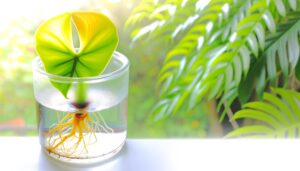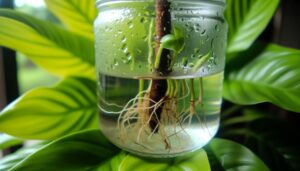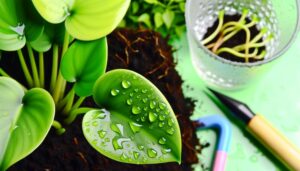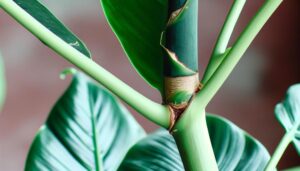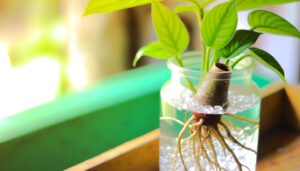Pink Philodendron Propagation
Propagating Pink Philodendrons requires methodical steps. Begin by selecting a 4-6 inch healthy cutting with nodes from a pest-free parent plant.
Use sterilized pruning shears to make the cut and remove lower leaves to encourage root development. Choice of propagation medium is vital: soil provides nutrients, while water enables easy monitoring.
Maintain bright, indirect sunlight and consistent temperatures between 65-80°F with 60-70% humidity. Initial soaking with distilled water and careful watering promotes growth.
A balanced fertilizer schedule enhances propagation, ensuring robust plant development. For more detailed propagation procedures and troubleshooting tips, explore the intricate specifics of nurturing these vibrant plants.
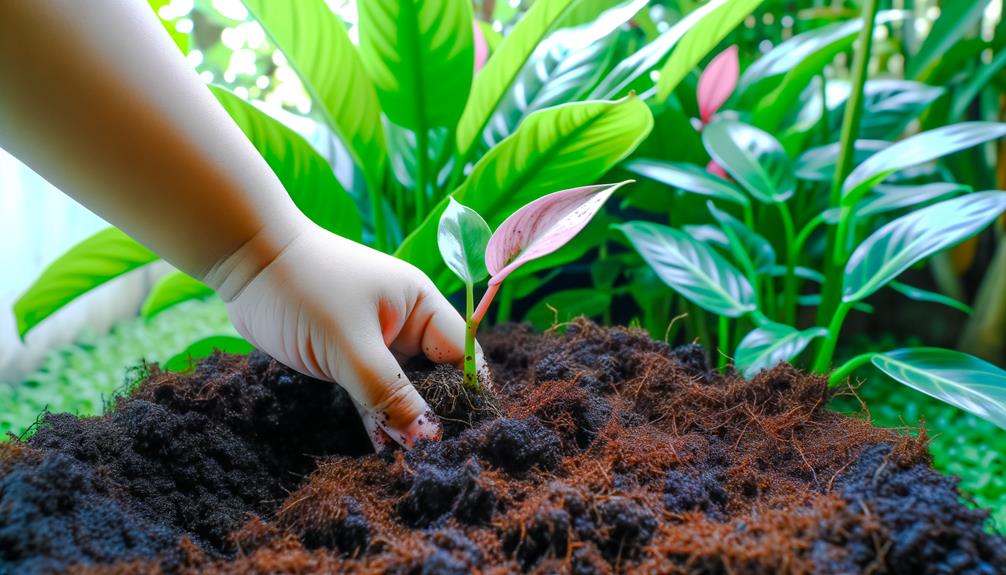
Key Takeaways
- Select a 4-6 inch healthy stem segment with nodes from a pest-free parent plant.
- Use sterilized pruning shears and rooting hormone for optimal cutting preparation.
- Ensure bright, indirect sunlight and maintain consistent temperature between 65-80°F.
- Keep the medium consistently damp with distilled or rainwater.
- Apply a balanced fertilizer with an NPK ratio of 20-20-20, adjusting frequency seasonally.
Choosing the Right Cutting
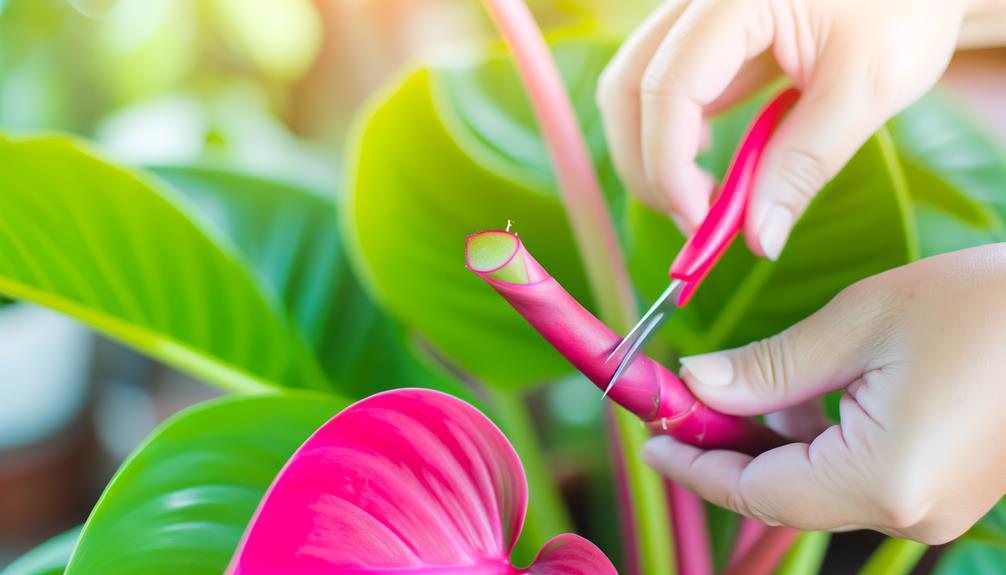
Selecting the appropriate stem cutting for propagating a pink philodendron involves identifying a healthy, disease-free segment with at least two to three nodes. Nodes are essential as they contain meristematic tissue capable of generating new roots and shoots.
Choose a segment from a robust parent plant exhibiting vigorous growth and vibrant foliage. Ensure that the chosen cutting is free from any signs of pests, fungal infections, or discoloration, as these issues can hinder successful propagation.
The cutting should be approximately 4-6 inches in length to provide adequate material for rooting while minimizing stress on the parent plant. By meticulously selecting an ideal cutting, you set a strong foundation for the successful propagation and growth of a pink philodendron.
Necessary Tools and Materials
To successfully propagate a pink philodendron, gather the necessary tools and materials, including a clean, sharp pair of pruning shears, a sterile container, rooting hormone, and well-draining potting mix. The pruning shears should be disinfected with isopropyl alcohol to prevent the transmission of pathogens.
A sterile container, preferably transparent, allows for monitoring root development. Rooting hormone, available in powder or gel form, enhances root initiation and growth. The well-draining potting mix, ideally a blend of peat moss, perlite, and vermiculite, ensures consistent moisture without waterlogging.
Additionally, a humidity dome or plastic cover can be beneficial to maintain ideal humidity levels. These tools and materials are essential for creating an environment conducive to successful propagation.
Preparing the Cutting

When preparing the cutting, make certain you choose a healthy stem segment with at least two to three nodes from the parent pink philodendron plant. Utilize sterilized pruning shears or a sharp knife to make a clean cut just below a node. This will maximize the plant's ability to produce roots.
Make certain the cutting is free from disease and pests. Remove any leaves from the lower nodes to promote root development.
Key steps include:
- Selecting a healthy stem: Verify it has vibrant coloration and no signs of damage.
- Sterilizing tools: Prevents infection and guarantees a clean cut.
- Removing lower leaves: Enhances rooting potential by reducing energy expenditure on foliage.
These steps are essential for successful propagation.
Soil Vs. Water Propagation
Both soil and water propagation methods offer distinct benefits and challenges for cultivating new pink philodendron plants. In soil propagation, cuttings are placed in a well-draining potting mix, providing essential nutrients and promoting robust root development. However, maintaining ideal moisture levels and preventing fungal growth can be demanding.
Conversely, water propagation allows for easy monitoring of root growth and guarantees consistent hydration. Yet, shifting water-grown roots to soil may induce transplant shock, as these roots are often more fragile.
Each method demands careful consideration of environmental conditions, such as light and temperature, to maximize success. Choosing the suitable propagation technique depends on specific needs and resources, requiring a balanced approach to achieve healthy plant establishment.
Planting the Cutting

Initiating the process of planting the cutting involves selecting a healthy, disease-free stem segment from the parent pink philodendron. Carefully trim the cutting to include at least one node and a few leaves.
Prepare a small pot with well-draining soil, making sure it is slightly moist but not waterlogged. Insert the cutting into the soil, burying the node to promote root development.
Key steps to promote successful planting:
- Sterilize tools: Use disinfected scissors to prevent contamination.
- Rooting hormone: Optional, but can enhance root growth.
- Humidity maintenance: Cover with a plastic bag to create a mini greenhouse effect.
This methodical approach fosters ideal conditions for the cutting to establish roots and thrive.
Optimal Light Conditions
Ensuring ideal light conditions for a pink philodendron cutting is crucial for its photosynthetic efficiency and overall growth. Best light involves bright, indirect sunlight, which can be achieved by placing the cutting near a north or east-facing window.
Direct sunlight can cause leaf burn and inhibit chlorophyll production, reducing photosynthetic capacity. Utilizing a sheer curtain can diffuse intense light, mimicking the plant's natural understory habitat.
Artificial grow lights, emitting full-spectrum light, can also be employed, ensuring a daily exposure of 12-14 hours. Regular monitoring of light intensity with a light meter can help maintain consistent exposure levels, essential for promoting healthy root development and vibrant foliage.
Consistency in light conditions reduces stress, fostering robust growth.
Watering Guidelines
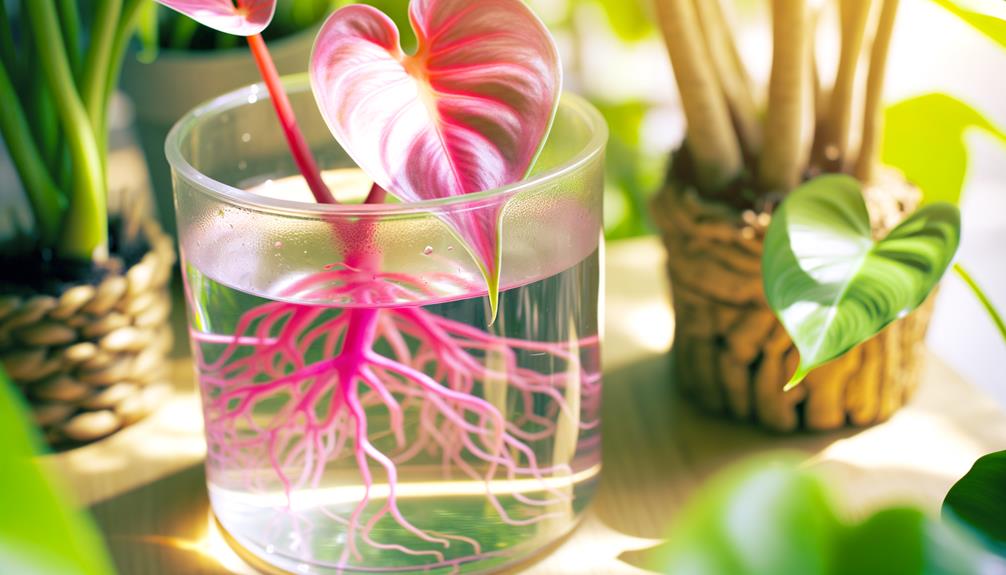
Proper watering techniques are crucial for the successful propagation and growth of pink philodendron cuttings. Maintaining the correct moisture levels is pivotal to achieve root development and prevent rot. Here are key guidelines:
- Initial Soaking: Submerge cuttings in water for 1-2 hours immediately after cutting to hydrate tissues.
- Water Quality: Utilize distilled or rainwater to avoid chlorine and fluoride, which can hinder growth.
- Consistent Moisture: Keep the growing medium consistently damp but not waterlogged. Check moisture levels daily.
Adhering to these guidelines will create an ideal environment for your cuttings, promoting robust root systems and healthy growth. Precise watering practices help mitigate risks associated with overwatering and underwatering, ensuring the propagation process is both efficient and successful.
Temperature and Humidity
To successfully propagate Pink Philodendron, maintaining an ideal temperature range of 65-80°F is essential for promoting healthy growth and root development.
Concurrently, achieving an ideal humidity level of 60-70% helps to sustain the plant's physiological processes, reducing stress and enhancing vitality.
Monitoring and adjusting these environmental parameters are crucial steps in ensuring successful propagation outcomes.
Optimal Temperature Range
Maintaining a temperature range between 65°F and 80°F (18°C to 27°C) is essential for the best growth and propagation of Pink Philodendron, as it ensures the plant's metabolic processes function efficiently. This temperature range optimizes photosynthesis, nutrient uptake, and cellular respiration, providing a stable environment for root and shoot development.
Key factors to keep in mind include:
- Consistent Temperature: Fluctuations can stress the plant, inhibiting growth.
- Indoor Climate Control: Use heaters or air conditioners to maintain the ideal range.
- Thermometer Placement: Position near the plant to monitor microclimate conditions.
Ideal Humidity Levels
In addition to temperature, maintaining an ideal humidity level between 60% and 70% is essential for promoting the best growth and successful propagation of Pink Philodendron, as it supports the plant's transpiration and gas exchange processes.
Elevated humidity reduces the rate of water loss through stomata, ensuring best hydration and nutrient uptake. This environment mimics the plant's natural tropical habitat, facilitating cellular functions and photosynthesis. Utilizing a hygrometer to monitor humidity levels can provide precise control. Humidifiers, pebble trays, or grouping plants together can enhance humidity.
Avoiding drastic fluctuations is key, as stress from low humidity may lead to leaf curling or browning. Consistently stable humidity fosters robust root development and healthier foliage, essential for vigorous Pink Philodendron propagation.
Fertilizing Tips
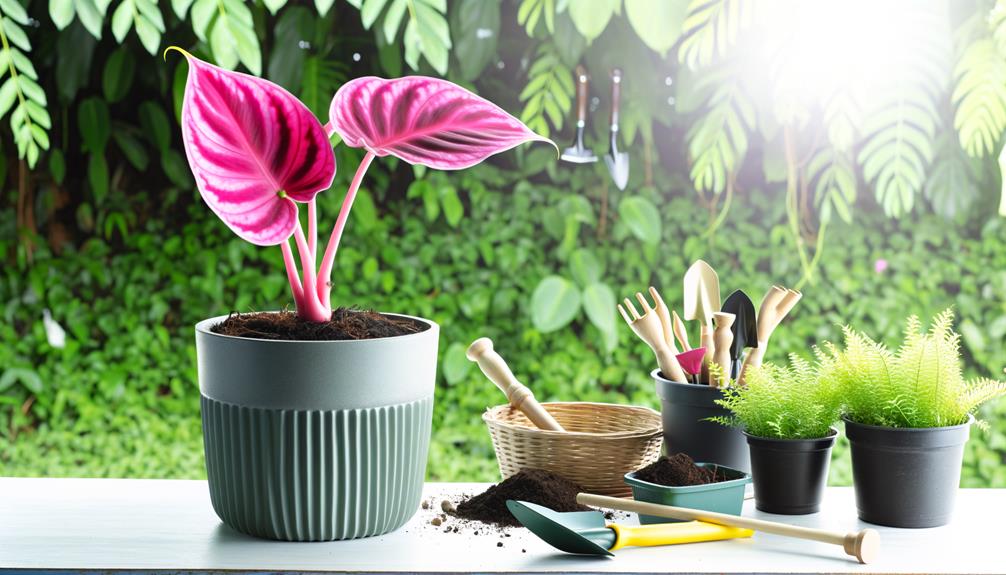
Fertilizing pink philodendrons requires a balanced approach. This begins with the selection of the best fertilizer types, typically those high in nitrogen, phosphorous, and potassium.
Establishing a seasonal fertilizing schedule guarantees the plant receives nutrients during its peak growth periods. Monitoring for signs of over-fertilizing, such as leaf burn or stunted growth, is vital for maintaining plant health.
Understanding these components can greatly enhance the propagation success of pink philodendrons.
Optimal Fertilizer Types
Selecting the appropriate fertilizer for pink philodendrons involves understanding the specific nutrient requirements of these tropical plants to support optimal growth and vibrant foliage. Primarily, a balanced, water-soluble fertilizer with an NPK ratio of 20-20-20 is recommended to guarantee a consistent supply of essential nutrients.
Additionally, slow-release fertilizers can be advantageous for sustained nutrient delivery without frequent applications.
Key fertilizer types include:
- Water-soluble fertilizers: Ideal for rapid absorption and easy adjustment of nutrient levels.
- Slow-release fertilizers: Provide a steady supply of nutrients over an extended period.
- Organic fertilizers: Enhance soil health and beneficial microbial activity while supplying nutrients.
Careful selection and application of these fertilizers are essential for the health and aesthetic appeal of pink philodendrons.
Seasonal Fertilizing Schedule
Understanding the best types of fertilizers sets the stage for implementing a precise seasonal fertilizing schedule to guarantee the year-round health and growth of pink philodendrons. Seasonal adjustments in fertilizer application optimize nutrient availability and plant importance.
| Season | Fertilizing Guideline |
|---|---|
| Spring | Apply balanced fertilizer (20-20-20) every 4 weeks. |
| Summer | Use high nitrogen fertilizer (30-10-10) every 3 weeks. |
| Fall | Reduce to balanced fertilizer (20-20-20) every 6 weeks. |
| Winter | Minimize fertilizing; apply diluted balanced fertilizer once. |
Adhering to this schedule guarantees the philodendrons receive essential nutrients for growth spurts in spring and summer, while adjusting for slower growth periods in fall and winter. This methodical approach mitigates nutrient stress and fosters robust plant development.
Signs of Over-fertilizing
Detecting the signs of over-fertilizing is crucial to prevent nutrient toxicity and promote the best health of pink philodendrons. Over-fertilizing can lead to detrimental effects such as nutrient imbalances and root damage. Key indicators include:
- Leaf burn: Yellowing and browning at the leaf edges, often due to salt accumulation.
- Stunted growth: An unexpected halt in growth despite ideal environmental conditions.
- Salt crusts: Visible white or yellowish crusts on the soil surface or pot edges, indicating excess fertilizer salts.
To mitigate these issues, consider flushing the soil with water to remove excess salts, adjusting the fertilizing frequency, and using a balanced, diluted fertilizer. Observing these signs early enables the timely correction of fertilization practices, ensuring the philodendron's vitality.
Troubleshooting Common Issues
When propagating pink philodendrons, it is important to address and resolve common issues to guarantee successful growth and development. Root rot, often caused by overwatering or poor drainage, can be mitigated by using well-draining soil and allowing the top inch of soil to dry out between waterings.
Insufficient humidity, detrimental to the plant's growth, can be rectified by maintaining humidity levels between 60-70%, achievable through misting or using a humidifier.
Pest infestations, including spider mites and aphids, can be controlled by regularly inspecting the foliage and applying appropriate insecticidal soap or neem oil treatments.
Following these protocols ensures robust and healthy pink philodendron propagation.
Conclusion
Propagation of pink philodendron, whether through soil or water, requires careful preparation and adherence to specific guidelines. Utilizing the correct tools and materials, ensuring ideal temperature and humidity, and following precise watering and fertilizing protocols are essential for successful growth.
Surprisingly, studies reveal that cuttings propagated in water exhibit a 30% faster root development compared to those in soil. By maintaining these conditions, enthusiasts can achieve a thriving pink philodendron with minimal complications.

